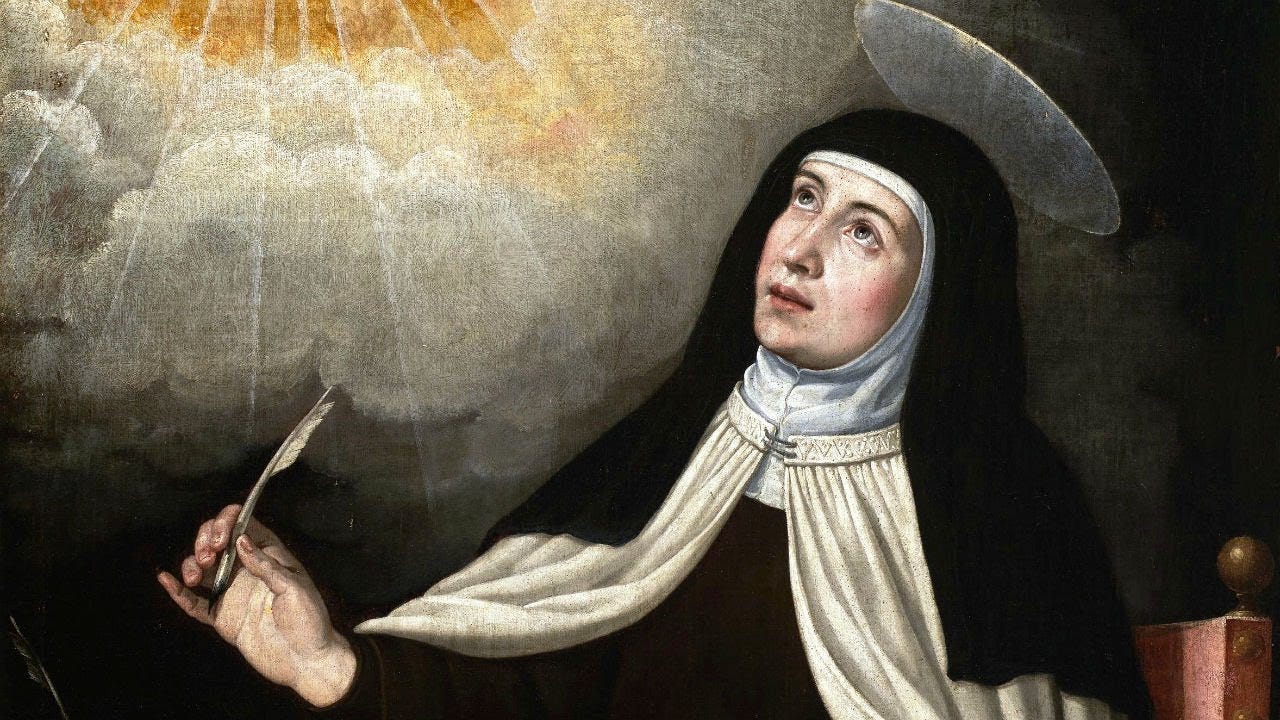Teresa Sánchez de Cepeda Dávila y Ahumada, or popularly known as Teresa of Avila, was an influential Spanish theologian of the 16th century. Though I’m pushing the boundaries of the medieval period by including her in this series, I love Teresa and want to highlight her contribution to post-Reformation monasticism and mysticism. I had hoped to write more during March for Women’s History Month, but it was quite a busy month! However, Give Me a Word highlights women’s history year-round so I didn’t grieve too much over this. We resume this series with the exemplary figure of Teresa of Avila.
Teresa was a Spanish nun in the Carmelite tradition in the mid 16th century (1515-1582). Though the Carmelite order of monasticism reached back to the 13th century, Teresa is known for reforming and revitalizing this movement of contemplative monasticism.
She was raised as a Christian and decided to enter monastic life at age 20. In her early years as a nun, she became interested in aesthetic practice and the mortification of the body to the extent of extreme illness. Her disdain for original sin caused her to deprive her body of things needed to thrive as a sign of rejection of the flesh. Influential on her developing understanding of sin and redemption was Augustine’s Confessions. She found it consolable that so great a saint could be so great a sinner.
Teresa is perhaps best known for her reform of the Carmelite order and her recorded visions in El Castillo Interior or Interior Castle. In this work, she documents the journey of faith as a set of interior chambers that lead one closer to union with God. For Teresa, the soul is a castle within which lies the possibility for union with the divine.
Teresa’s other works include an autobiography titled The Life of St. Teresa of Jesus and an instructional book of prayer called The Way of Perfection. Her influence on Christendom and the world around her was great with some scholars presenting the idea that Descartes was influenced by Teresa’s work on the interior life and intellectual growth. His Meditations on First Philosophy bear striking resemblance to Interior Castle though he was active some fifty years after Teresa. Additionally, Teresa was the first woman to be recognized as a doctor of the church in 1970.
Teresa’s theology of prayer, the interior life, and sanctification deserve careful reflection, though that will have to be saved for another day. The purpose of these portraits is to expose my readers to diverse historical figures and inspire further interest. As always, I like to let the people I highlight speak for themselves, so I am attaching an excerpt from Chapter 1 of Teresa’s Interior Castle. Enjoy and let me know if this is your first time encountering this exemplary Spanish theologian!
“In fact, however acute our intellects may be, they will no more be able to attain to a comprehension of this than to an understanding of God; for, as He Himself says, He created us in His image and likeness. Now if this is so--and it is--there is no point in our fatiguing ourselves by attempting to comprehend the beauty of this castle; for, though it is His creature, and there is therefore as much difference between it and God as between creature and Creator, the very fact that His Majesty says it is made in His image means that we can hardly form any conception of the soul's great dignity and beauty….Now let us return to our beautiful and delightful castle and see how we can enter it. I seem rather to be talking nonsense; for, if this castle is the soul, there can clearly be no question of our entering it. For we ourselves are the castle: and it would be absurd to tell someone to enter a room when he was in it already! But you must understand that there are many ways of "being" in a place. Many souls remain in the outer court of the castle, which is the place occupied by the guards; they are not interested in entering it, and have no idea what there is in that wonderful place, or who dwells in it, or even how many rooms it has. You will have read certain books on prayer which advise the soul to enter within itself: and that is exactly what this means.”





Definitely my first time hearing about her. I enjoy the art in these posts.